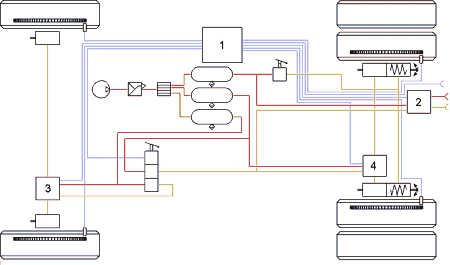|
|
Electronic Pneumatic-brakes

| Electronic components |
| Control device | 1 | |
| Proportional-relay-valve front axle regulation | 3 | |
| Proportional-relay valve rear axle regulation | 4 | |
| Proportional-relay valve
trailer regulation | 2 |
Assignment
Should the pneumatic brake be fitted with an electronic control system, it's character is changed, but it still looks, at least from the outside, very much the same, because the operation is still carried out pneumatically.
Thus, the air-pressure production,- the filtering. and -the drying are still preserved. The air reservoirs, brake circuit and with it, the four-circuit protection valve are still necessary. However, behind the two-circuit brake
valve, it's a different story all together. In this case, the automatic load-dependent brake valve (ALB) is missing, and there are proportional valves (in 4 and 5) which, in any event, block the path between the brake valve
and the wheel cylinders, also when the brake is electronically intact.
Function
The best thing to do, is to use the explaination for the regulation of the wheel sensors, which earlier, were used only for the ABS-function. This way, the control device can determine the amount of delay or the slip of
each wheel. the signal can be so finely broken down that, even when braking very lightly, any difference, eg., between the axles is registered. The control device now has the job to transfer the driver's wishes when
braking, registered through the distance sensor on the brake valve to all the wheels and the trailer evenly. Through a proportional relay-valve, the respective pressure in the wheel cylinder is regulated and constantly
checked to ensure that the braking values are correctly maintained. All specific features like eg., advanced response (approx. 1 bar) can now be called up from the identity fields in the control device. This brake not only
regulates differently, it can also do more than the solely pneumatic regulated brake. Thus, it also maintains the once-initiated braking operation, even when travelling downhill. A stronger operation of the brake valve is
not necessary. Longer periods of operation can also somewhat compensate for varying brake-pad wear. Through a button on the dashboard, it's even possible to activate a hill-holder to safely pull-off on an uphill.
Why is the pneumatic part of the brake valve still necessary? For one thing, the 'pedal feeling' must naturally, through counter pressure be present. Added to this, the safety aspect with trucks, is, of course, very
important. In a situation where no electricity exists, the proportional valves (in 3 and 4) open, so that the brakes
function once again pneumatically, however, only without taking disturbance variables like ,eg., the loading, into consideration.
Parts of the electrics/electronics have been simplified or left out so that the diagram
does not appear overloaded. The warning lights and dials on the dashboard are not shown, neither are the sensors for the brake-pad wear indication. The Can-Bus is also not mentioned in the diagram. It is
indispensable as a connection to the engine, the retarder and the gearbox. Almost more important still, is the communication between the tractor control device and the EBS-trailer brake-valve. The data connection and
the remaining electrics have their own trailer interface.
|
|